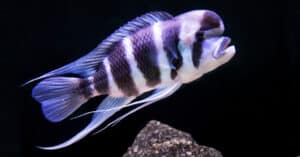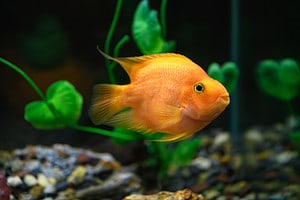Choosing the best tank mates for your flowerhorn cichlid can be a daunting endeavor. Cichlids are notorious for being aggressive and territorial fish, with the flowerhorn hybrid being no exception. Finding suitable tank mates for these fish can be difficult, especially if your flowerhorn is already mature. Here are some ideas for compatible tank mates for your flowerhorn, along with tips on housing them with other fish.
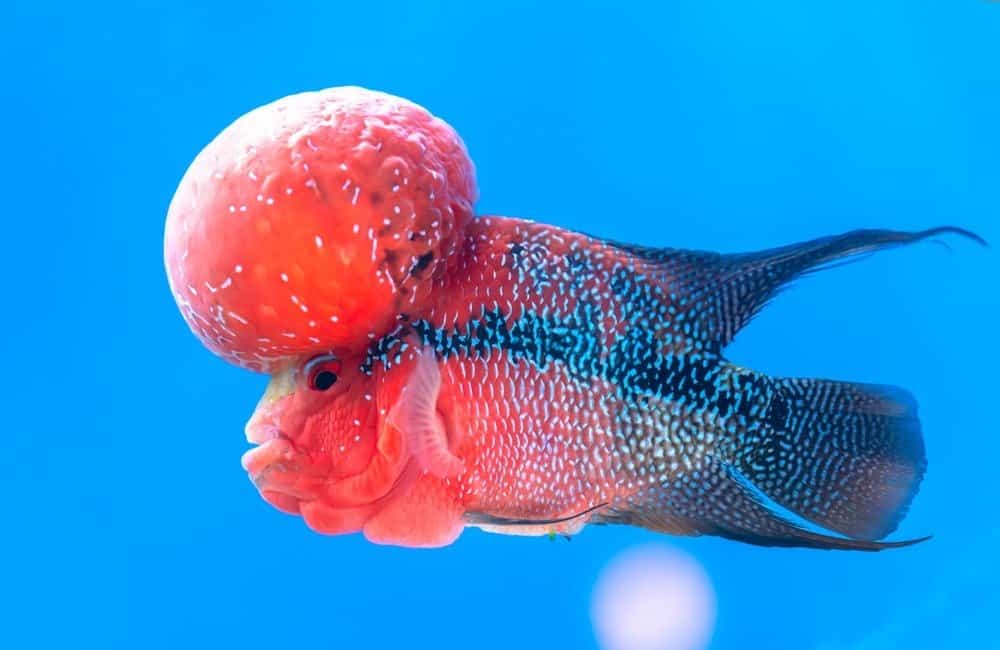
Flowerhorn cichlids do best in a tank of at least 75 gallons with a pH between 7.4-8.0.
©Huy Thoai/Shutterstock.com
1. Silver Arowana (Osteoglossum bicirrhosum)
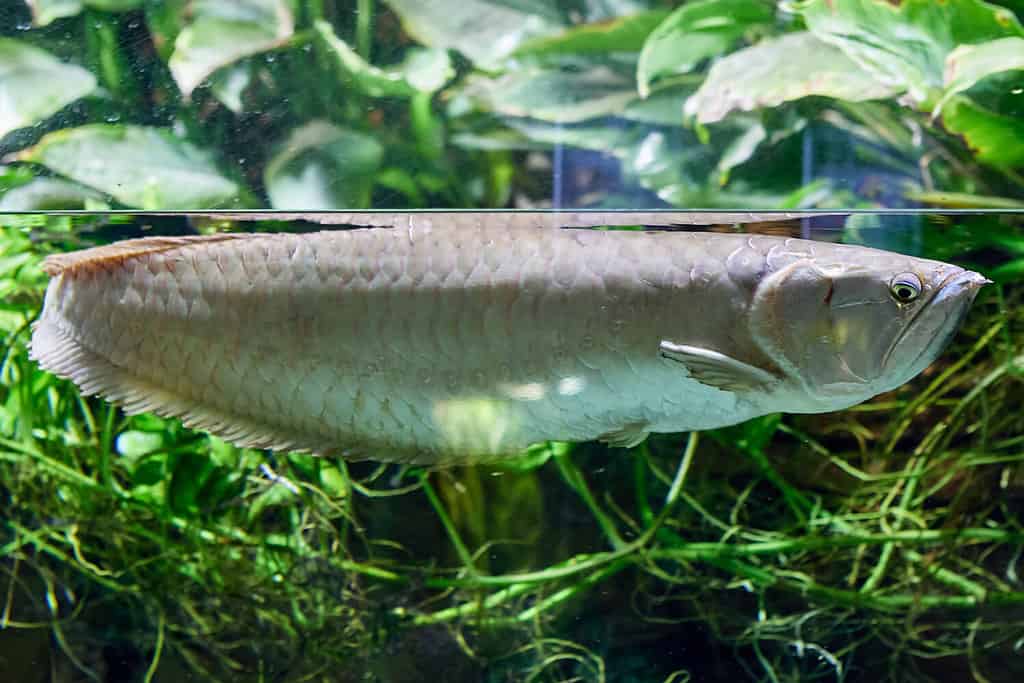
Arowanas are stunning fish to have in your tank but come at a high price.
©Grigvovan/Shutterstock.com
A silver arowana won’t challenge your flowerhorn in aggression, but it will in size. Arowanas can grow to be over 3-feet long and require a large tank of at least 250 gallons. It would be very hard for your flowerhorn cichlid to bully a behemoth like the silver arowana, considering flowerhorn cichlids max out in size at around 12 inches. These are also somewhat difficult fish to take care of, and expensive to procure, so it might be a match only for advanced aquarists.
2. Oscars (Astronotus ocellatus)

This orange color pattern is one of many different colors oscars can have.
©Boris Bulychev/Shutterstock.com
Many types of Oscars can be suitable tank mates for all types of cichlids, as they are around the same size and aggression level. Most species can grow up to 14 inches long, which is plenty big to keep up with your flowerhorn. Oscars also have distinct personalities which can make them a fun pet fish to keep, and a good choice if you’re looking to have a bit of interaction in your tank. Another bright side of keeping Oscars is they’re one of the easier tank mates to care for!
3. Jaguar Cichlid (Parachromis managuensis)
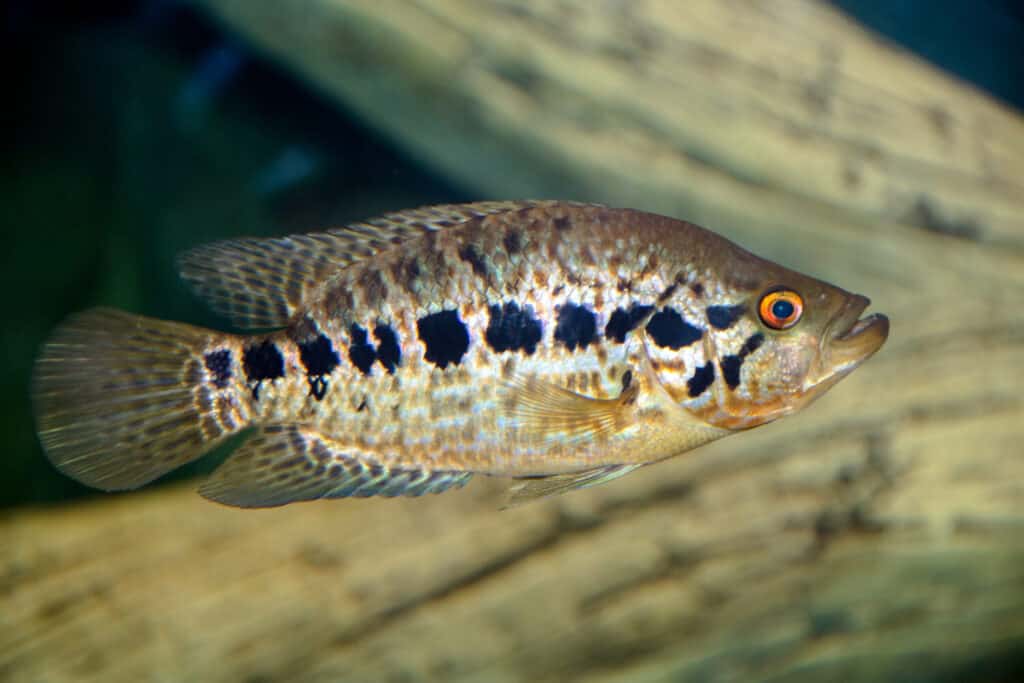
Other cichlids, such as the
jaguar
, are one of the more suitable tank mates for flowerhorns.
©Licvin/Shutterstock.com
One of the best challengers (and tank mates) for your flowerhorn is a jaguar cichlid. These are beautifully spotted large fish reaching up to 16 inches at maturity. They are also aggressive, since they’re a cichlid. Ensuring you have plenty of space for the two of them (at least 100 gallons) can ensure they each have some space for themselves.
4. Spotted Hoplo Catfish (Megalechis thoracata)
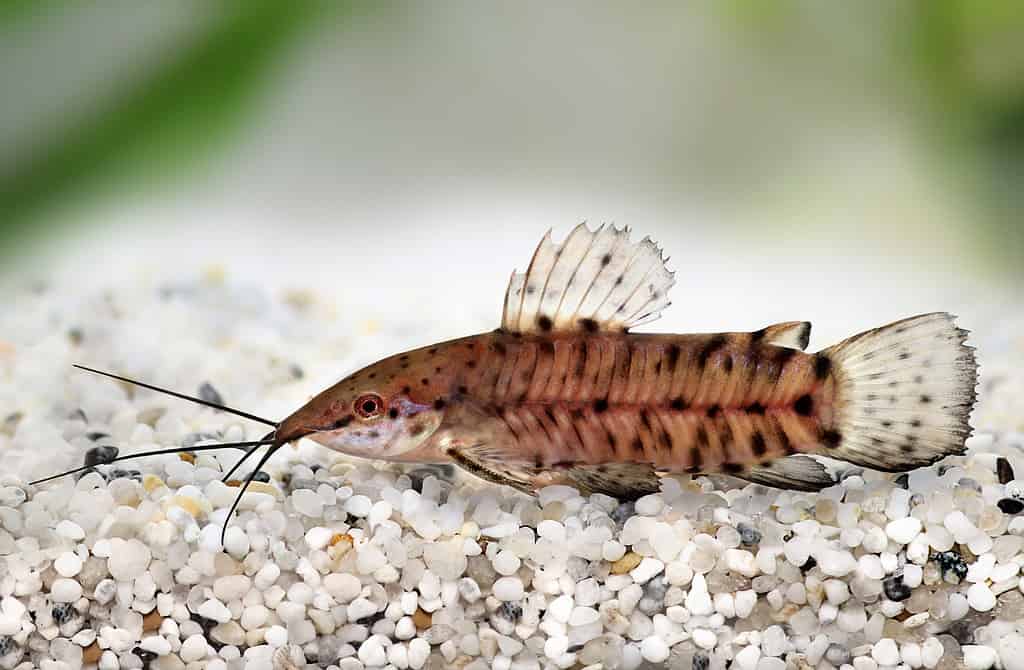
Spotted hoplo
catfish
occupy a different area of the tank, making them suitable flowerhorn companions.
©Mirko_Rosenau/ via Getty Images
The spotted hoplo catfish is a good tank mate for flowerhorns for a few reasons: they live at the bottom of the tank and prefer to have some cover, and they aren’t necessarily “small” fish, reaching up to 6-7 inches at maturity. By having some logs or other form of cover on the bottom of the tank, there’s a good chance these two fish will never interact. This is ideal for the aggressive flowerhorn, and the more peaceful catfish will appreciate being left alone, too.
5. Bichir (Polypterus spp.)
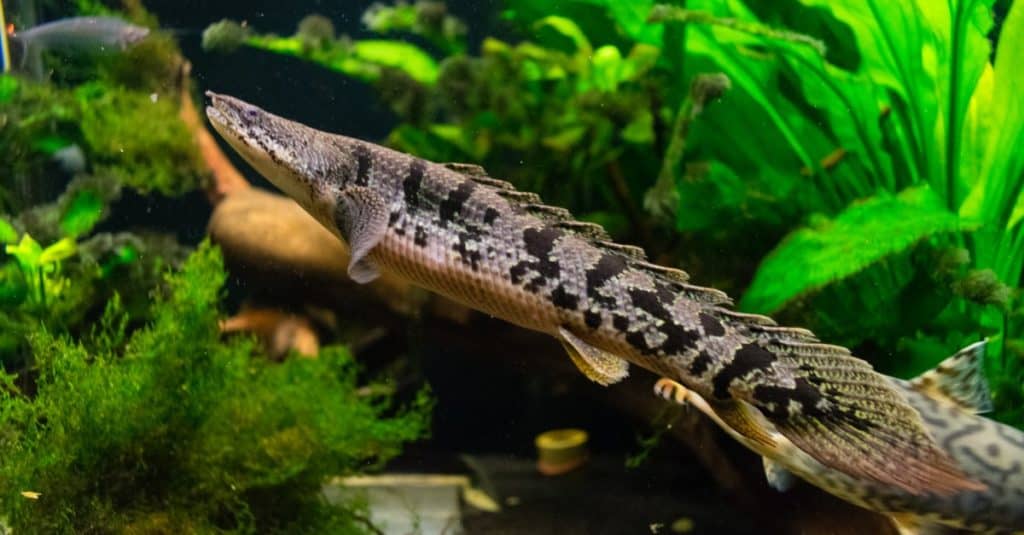
Another common name for the bichir is “dinosaur eel” or “
dragonfish
.
©Rollibolly/Shutterstock.com
If you want a tank full of unique looking fish, consider adding a bichir. They look like something out of a fantasy movie, with an intriguing, mystical appearance. They are a good match for a flowerhorn cichlid as they can match their aggression level and even outgrow the cichlid. These ancient looking fish can get up to a whopping 30 inches in length! In case your flowerhorn does get into a scrap with this fish, their armor-like scales will protect them from getting physically harmed.
6. Silver Dollar (Metynnis argenteus)
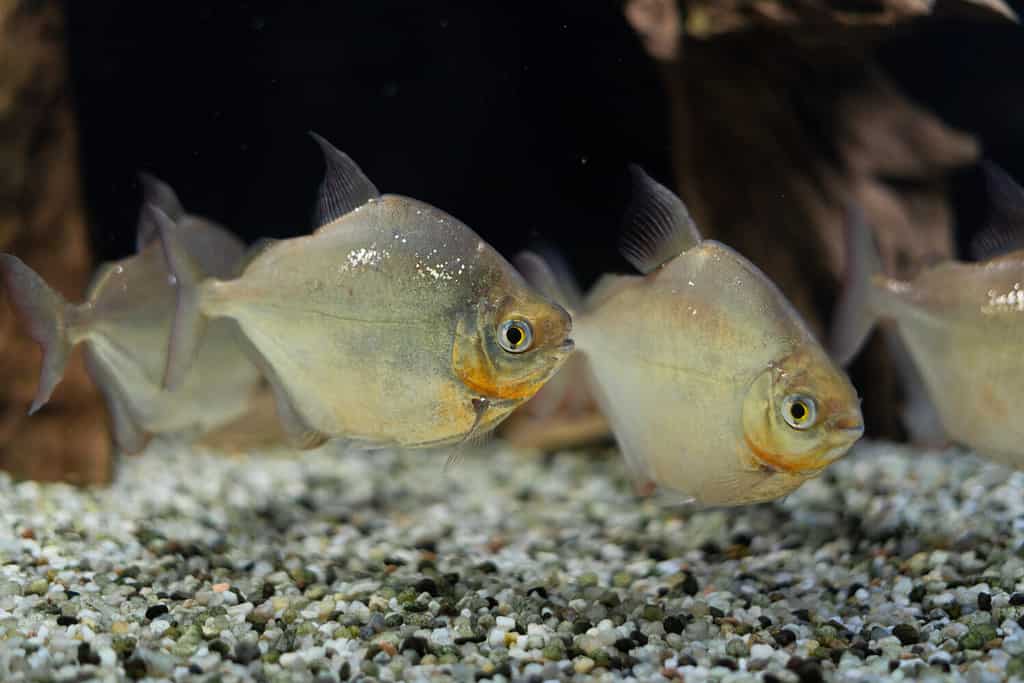
Having multiple silver dollar fish in your aquarium can be entertaining for you and your cichlid’s!
©Lysenko Andrii/Shutterstock.com
It seems counter-intuitive to put a bunch of smaller fish in with your flowerhorn, but not in the case of silver dollar fish. Though they are small, they are faster than your cichlid, making a quick getaway easy as pie. They get their name from their shiny, silvery appearance which can contrast nicely with the bright colors of a flowerhorn cichlid.
Additionally, the schooling behavior of these fish can help your flowerhorn feel more comfortable in its tank. Ideally, you’d keep around six of these fish together. To safely keep your flowerhorn and a school of these fish, your tank might need to be close to 200 gallons. Surprisingly, these fish can get between 6-12 inches!
7. Giant Gourami (Osphronemus goramy)
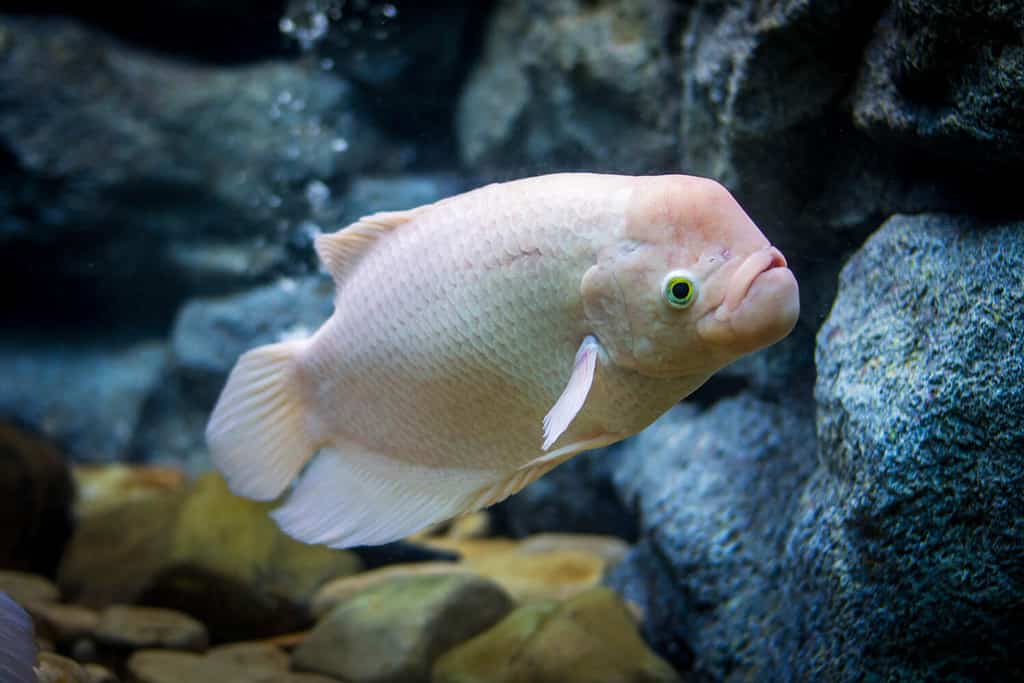
While it’s not visually as appealing as the flowerhorn, it can stand up against any acts of aggression.
©Watcharin Tadsana/Shutterstock.com
Anything with “giant” in the name is probably a safe tank mate choice. The giant gourami can max out at 24 inches long, which is twice that of a mature flowerhorn. They’re on the more peaceful end of the temperament scale, fortunately, but require at least 250 gallons of water. This can make them unattainable to the average aquarist, especially when adding in the flowerhorn’s own tank size requirements.
8. Jack Dempsey (Rocio octofasciata)
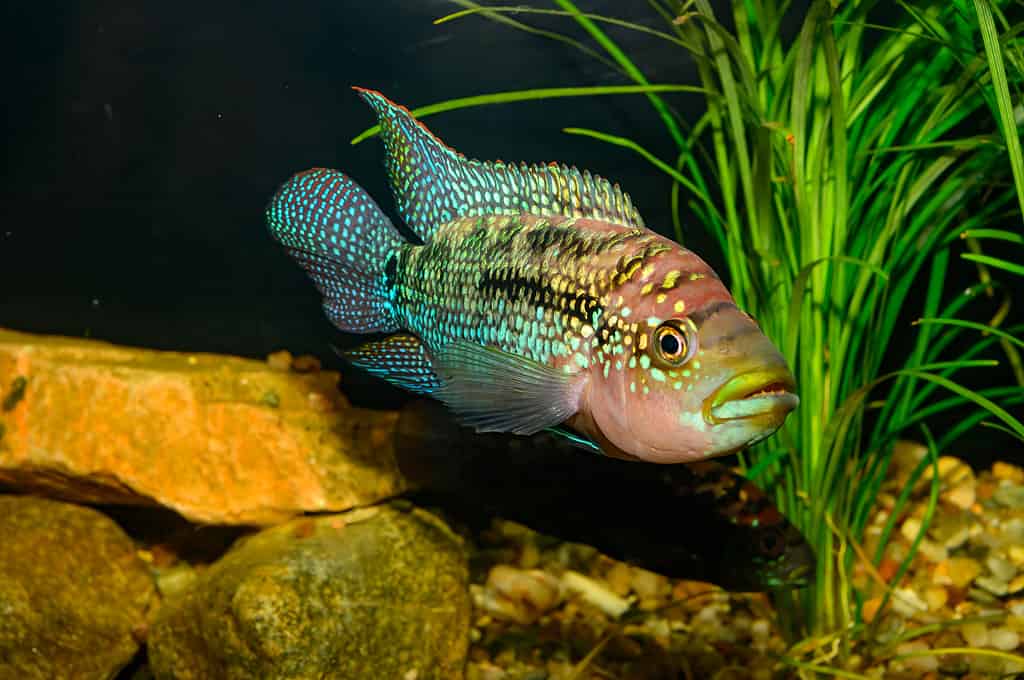
This large fish is a challenger in both behavior and looks for the flowerhorn cichlid.
©Karel Zahradka/Shutterstock.com
This is another type of cichlid which come in a variety of striking colors and personalities to match. A match-up between one of these cichlids and a flowerhorn would be pretty even, since they get about the same size and have a similar demeanor.
9. Wolf Cichlid (Parachromis dovii)

Groups of wolf cichlids can live agreeably with other cichlids given enough space.
©Borislav/ via Getty Images
A whopper of a fish, wolf cichlids can reach up to 28 inches long! With this large size comes a fairly large tank, so to house this giant and a flowerhorn you’d need close to a 250-gallon tank. These are beautiful fish with brightly colored patterns on their faces and a muted blue color, which would go well with the bright warm colors of a flowerhorn.
10. Pacu Fish (Colossoma macropomum)
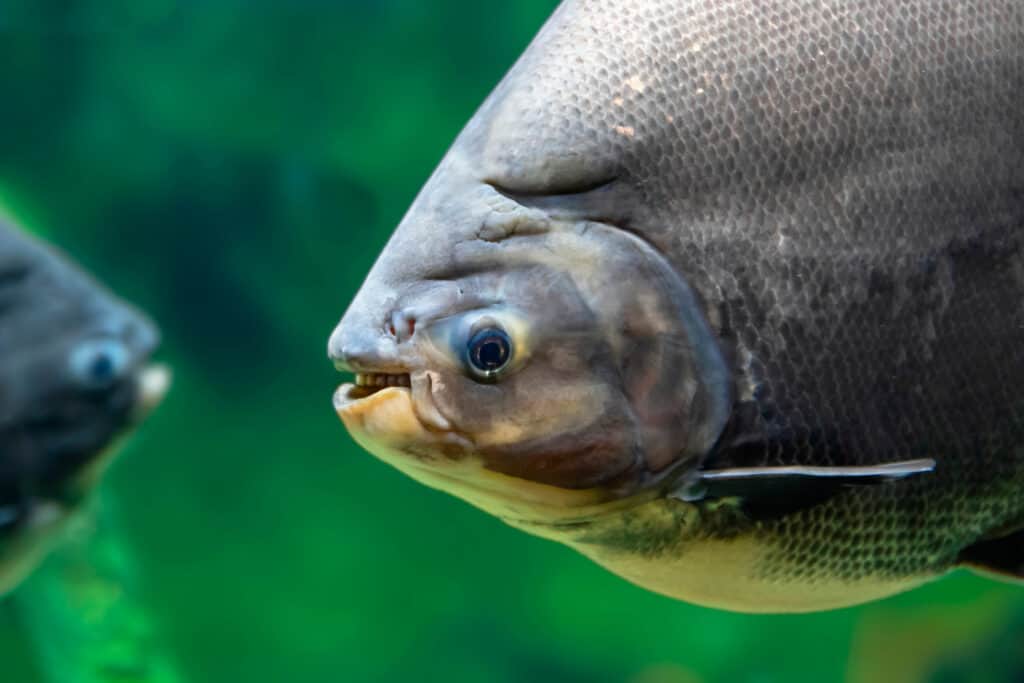
The pacu fish has a set of teeth resembling a human’s!
©Edvard Ellric/Shutterstock.com
Pacu fish are the piranha’s vegetarian relative and, surprisingly, can get on well with a cichlid. They’re relatively peaceful fish unless they’re antagonized, in which case they will protect themselves. Unfortunately, this is another fish that on its own requires at least 250 gallons. Pacu are also not the easiest fish to care for, so if you’re not comfortable with your fish-keeping skills, look for another companion for your flowerhorn.
11. Common Plecostomus (Hypostomus plecostomus)
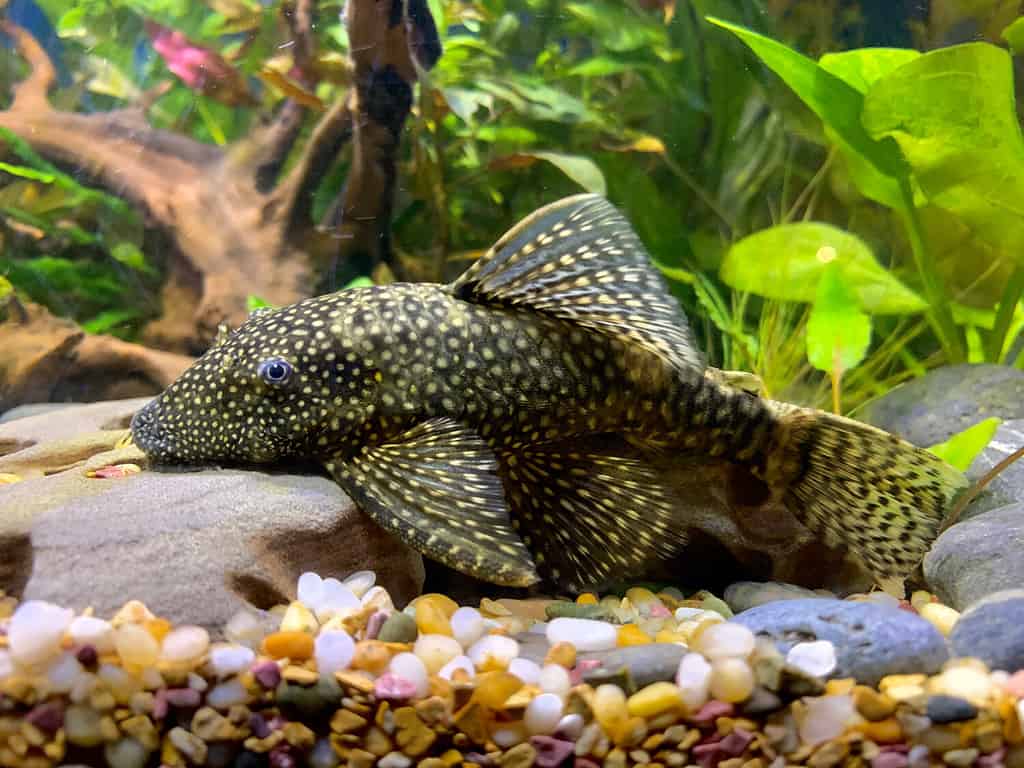
Plecos are favorites of aquarists due to their calm demeanor, clean-up capabilities, and ease.
©TTONN/Shutterstock.com
A common Plecostomus is an ideal tank companion for just about any fish. These tolerant and easy-going fish like to stick to the glass or bottom of the tank. If you provide little caves or nooks for it to hide, that’s even better! At full size, most plecos can get up to 24 inches long, which should be sizeable enough for your cichlid to avoid picking a fight. Like the bichir, plecos have some armor on their backs to defend themselves in case your flowerhorn decides to challenge them.
12. Tinfoil Barbs (Barbonymus schwanenfeldii)

The tinfoil barb adds an additional touch of color without overwhelming the main attraction of the tank.
©ivSky/Shutterstock.com
These are very similar to the silver dollar fish in attitude, color, behavior, and size. Tinfoil barbs are mostly silver but have a touch of orange on their fins and tail. They are also schooling fish like the silver dollars. The schooling behavior and fast movements of tinfoil barbs help keep them safe from the cichlid. As a bonus, having schooling fish adds some enrichment and intrigue to your tank.
13. Red Tail Shark (Epalzeorhynchos bicolor)
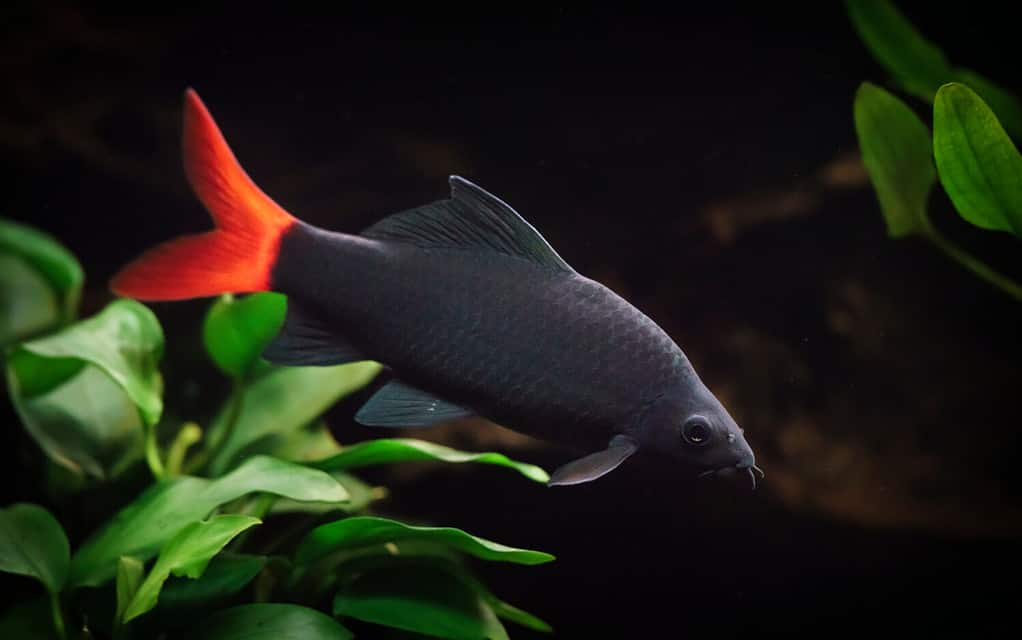
The sleek black body along with the brightly contrasting red tail makes this fish an interesting addition.
©tupulointi/Shutterstock.com
Despite their name, these fish are not at all related to sharks. Red tail sharks can get up to 6 inches, and though that’s about half the size of a fully mature flowerhorn, they make up for that disparity in their aggressive and territorial attitude. These “sharks” make for the best tank mates when they’re given their own little cave or hide-out to defend.
While they have one of the smallest tank requirements on this list at around 55 gallons, they are more difficult than a lot of other species on this list to care for.
14. Clown Loach (Chromobotia macracanthus)
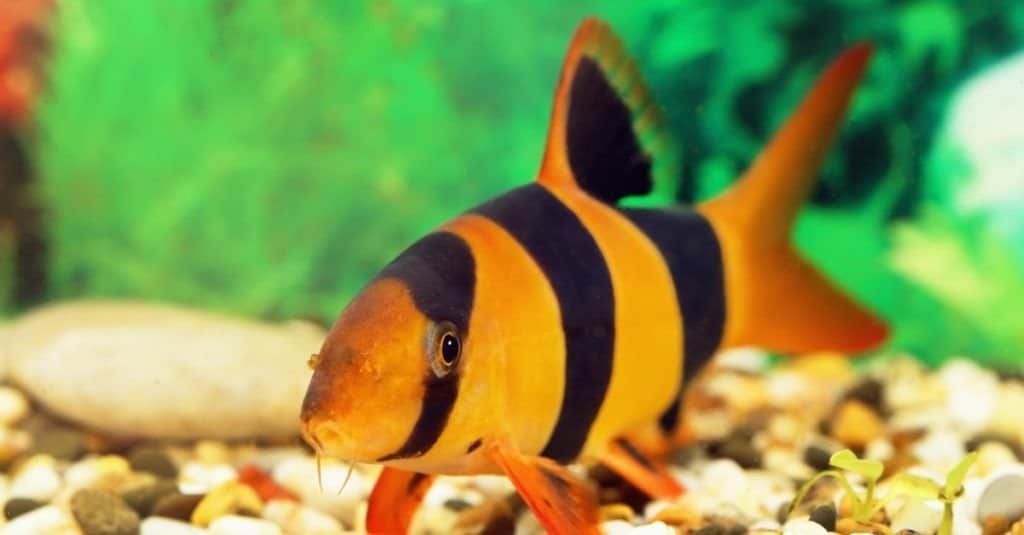
When properly cared for, a clown loach can live up to 20 years!
©Grigorii Pisotsckii/Shutterstock.com
Clown loaches can help keep with the bright and warm colored theme throughout your flowerhorn tank. While they’re not as aggressive or as large as flowerhorns (though they are comparable, at around 11-12 inches when fully grown), this is another speedy fish that can out-swim most instances of danger. Clown loaches also like to live with a few others of their kind. With this species and the flowerhorn, you should have a fairly lively tank.
15. Blood-Red Parrot Cichlid (Amphilophus citrinellus × Vieja melanurus)
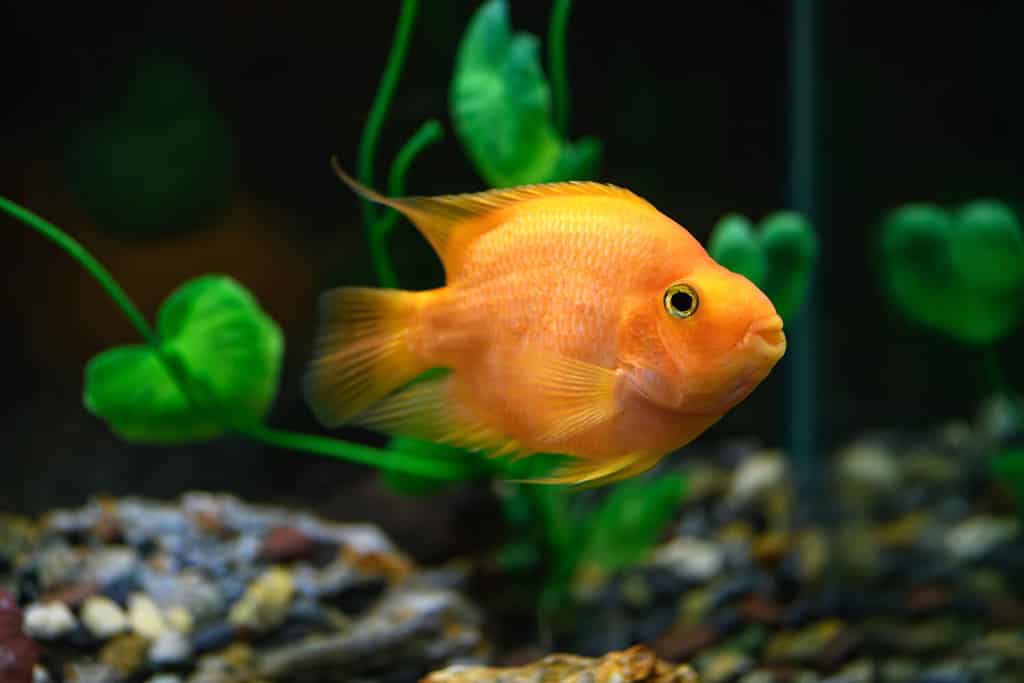
These parrot cichlids are range from orange to a deep red color.
©Bk87/Shutterstock.com
Parrot cichlids, including this hybrid, are also aggressive and can get up to 10 inches in size. Due to it being a smaller cichlid, it’s best to keep this species with a slightly smaller flowerhorn, if possible. Their hybridization and breeding have sparked controversy amongst some avid fish-keepers, so you might find some trouble acquiring one of these fish.
Summary of Best Tank Mates for Flowerhorn Cichlids
| Name | Gallons Recommended | Ease of Care |
|---|---|---|
| 1. Silver Arowana | 250 gallons | Advanced |
| 2. Oscars | 55+ gallons | Easy |
| 3. Jaguar Cichlid | 125 gallons | Advanced |
| 4. Spotted Hoplo Catfish | 55 gallons | Easy |
| 5. Bichir | 90 gallons | Intermediate |
| 6. Silver Dollar | 75+ gallons | Moderate |
| 7. Giant Gourami | 250 gallons | Moderate |
| 8. Jack Dempsey | 55 gallons | Moderate |
| 9. Wolf Cichlid | 125 gallons | Moderate |
| 10. Pacu | 250 gallons | Advanced |
| 11. Common Plecostomus | 50+ gallons | Easy |
| 12. Tinfoil Barbs | 70 gallons | Moderate |
| 13. Red Tail Shark | 55 gallons | Easy to Moderate |
| 14. Clown Loach | 100 gallons | Advanced |
| 15. Blood-red Parrot Cichlid | 30 gallons | Moderate |
Is a Tank Mate Right for Your Cichlid?
Some people say the best tank mates for a flowerhorn cichlid are no tank mates at all. This can be true depending on the demeanor of your fish and how old it is. For example, older fish that are already at maturity can be difficult, if not impossible, to house with other fish. An already territorial and aggressive fish is not going to change their ways.
How To Minimize Aggression Between Flowerhorns and Tank Mates
So, if you want to keep an additional species of fish in with your flowerhorn, plan for this while they are small. This means that if you’ve not yet acquired your flowerhorn cichlid, try to get a young one. Shortly after, you’ll want to get the other species you desire. Also, you’ll want to avoid housing two adult male flowerhorns together, as this almost certainly will end with one of them being killed by the other.
Another way to minimize aggression between your cichlid and other species you keep in your tank is to make sure everyone is fed in abundance. This will cut down on aggression due to fish being hungry. In addition to keeping your fish well-fed, you also have to make sure there is enough size for everyone to swim around. Flowerheads require a minimum of 75-125 gallons of water, and this will increase with the number of fish you decide to have. It would not be unreasonable to suggest a 200+ gallon tank if you plant on keeping multiple large species of fish together.
The final tip is to pick fish that are similar in size and temperament to your flowerhorn. Generally, you don’t want anything smaller than your flowerhorn cichlid in the tank with it unless it is a fast fish. Other semi-aggressive or aggressive fish can handle the bullying your cichlid might inflict upon them.
Final Thoughts and Considerations
Flowerhorn cichlids can nip at and injure (or even kill) other fish in the tank with it, so the risk is present that you might incur some loss of fish this way. On the flip side, the other tank mates might do damage to your flowerhorn. These are typically expensive fish that are purchased for their unique appearance, so damage to this fish could not only hurt it physically but might also not be ideal in a centerpiece fish.
While there are some ways to cohabitate flowerhorn cichlids and other species successfully, it fully depends on the skills of the aquarist and the personality of the fish. You might find it best for you and all your fish to have a flowerhorn-only tank. Be sure to do thorough research on all the fish on your wish list to ensure you have the right tools, setup, and expectations when it comes to introducing your flowerhorn cichlid to the best tank mate possible. Monitor your fish when introducing them and stay prepared for the possibility of having to separate them should your flowerhorn pose a risk to its tank mate’s health.
The photo featured at the top of this post is © luis2499/Shutterstock.com
Thank you for reading! Have some feedback for us? Contact the AZ Animals editorial team.



